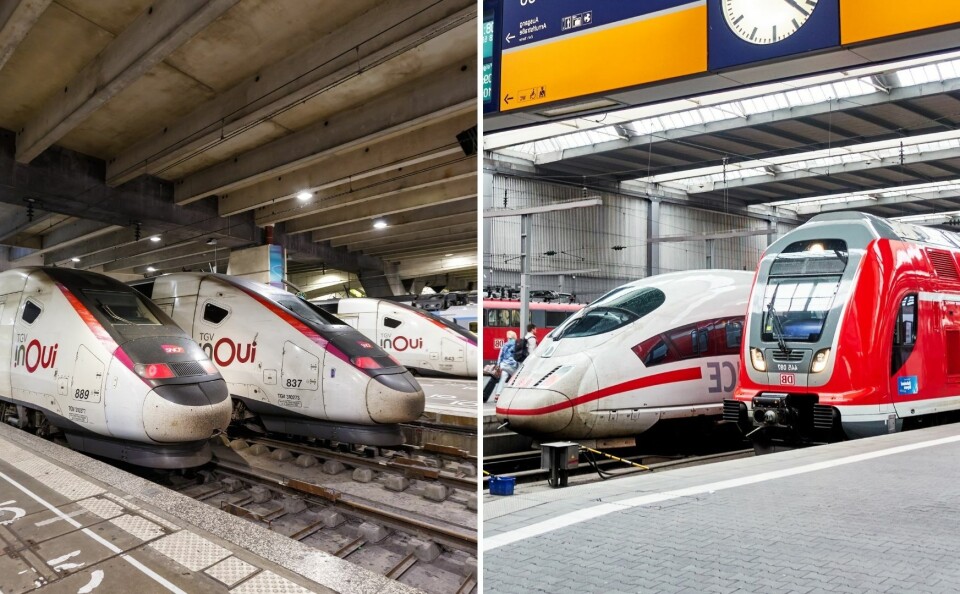-
Is it time to shorten France's school holidays?
Pascal Bressoux, professor of educational sciences at the University of Grenoble Alpes, explains why the school timetables need a rethink
-
Savoyards poke fun at Parisians over snow disruption
A few centimetres shut down capital but for those in Savoie ‘it’s time to clear the chalet steps so no one slips after an apero’
-
Lookalike La Poste site accused of misleading users in France
Reader says he was overcharged by poste-en-ligne.com and his letter did not even arrive
‘French train travel is a joy compared to Germany’s awful rail system’
Columnist Richard Ogier compares travelling by train in the two countries and why they are so different

Given the lamentable state of German train travel currently, it’s good to be back on French trains.
The big summer travel story in Germany has been that amid major scheduling and infrastructure problems, less than 60% of long-haul trains arrived on time.
In France, there are issues, of course, however a comparative report in 2019 found that an encouraging 91% of French trains arrived less than five minutes late.
Older French people will still remember the little Micheline passenger trains, and the iconic travel posters of them, chugging through French countryside astride lovely valleys.
However by the end of World War Two 80% of tricolore locomotives and wagons were destroyed.
France keeps cutting journey times
In the years since, French rail, and particularly the marvellous TGV, has become a symbol of French industrial pride and know-how.
And it’s a still developing story.
In 2017, travel time from Paris to Bordeaux narrowed to two hours and four minutes; to Rennes, the likeable university city in Brittany, to one hour and 25 minutes.
In 2016, travel time between Paris and Strasbourg, home to the European parliament, was cut by half an hour to one hour 50 minutes.
By way of comparison, Paris and Munich are a similar distance from Strasbourg, and yet travel time to the Bavarian capital is three hours 50 minutes, if you’re lucky.
And usually you won’t be.
Stuttgart station is huge problem
Travelling to Munich usually means passing through the Stuttgart hub; and that city’s main station overhaul, called Project 21, Germany’s biggest infrastructure development and an eyesore, is a swarm of passengers struggling along precariously narrow platforms to make (or often, not) connecting trains.
Costs on the renovation, years behind schedule, have ballooned from €2.5billion to €8.2billion.
The ‘Bermuda Triangle’ of German rail
Everybody in Germany has a train story, or seems to: of trains stopping mid-journey on open tracks; of trains heading in the wrong direction after points were mistakenly changed; of passengers ending up in a remote village after missing multiple connections, as happened to my two teenage children.
Hanover, Germany’s sixth-largest station, is the Bermuda Triangle of German rail, according to a Swiss journalist.
“You drive in but never quite know when you’re going to drive out again,” he wrote over the summer. “So far, I’ve missed every correspondence train.”
German trains reverse out of some stations
German media is reporting that old infrastructure in eight of the country’s most industrial and densely populated areas is a big part of the problem.
Due to the way the network is organised, a disruption at one of these ‘nodes’ has an impact on all traffic.
As well, the system is veritably peppered with so-called Kopfbahnhofs, or ‘head stations’, where a train enters and must reverse to get out (this includes Stuttgart, Leipzig and Hamburg, as well as, oddly, Frankfurt, even though the city is bang in the middle of Germany).
Subsidised French operators in debt
The French rail system is no bed of roses, of course.
Tragically, eleven lives were lost and 42 people injured in the Paris-Strasbourg time trials in 2015, when a TGV derailed at Eckwersheim north of Strasbourg — the deadliest French rail accident in 25 years.
Heavily subsidised, French railways have become notorious accumulators of public debt.
The recent Spinetta Report for the government confirmed that French state-owned rail operator, SNCF, was an eye-watering €54billion in the red.
Also, a recent survey suggested that the public doesn’t quite have the pride in French rail it once did.
TGV is success story
Yet the consumer strengths of an impressive system remain, not least the speed, regularly 320km/h (the record is 574.8km/h).
If your TGV is more than 30 minutes late, you are reimbursed 25%; more than two hours late, 50%; more than three hours, 75% of the full ticket price.
One fills out an online form with a response guaranteed within five days.
The TGV has opened up great swathes of France to business and tourism, especially in the north and west.
To think that almost every regional agglomeration in France is today only two or three hours from the capital, as the Spinetta report highlighted.
And still with some very beautiful scenery out of the window as you go, and travelling low-carbon.
Meanwhile France’s prices are favourable compared to Germany, Austria, the US and the UK (especially England) according to analysis by transport-focused tech company Fleet Logging, published on frommers.com.
Richard Ogier is an Australian journalist based in Strasbourg. He has written on France and Germany for the LA Times, Canadian Globe and Mail, Liberation, Independent and for his native Australian press.
Related articles
Planes, trains, cost, carbon - how do you travel to and from France?
Can I take my bike on a trip across France using trains?
‘Smelly’, ‘exceptionally clean’: Your views on French train conditions
























